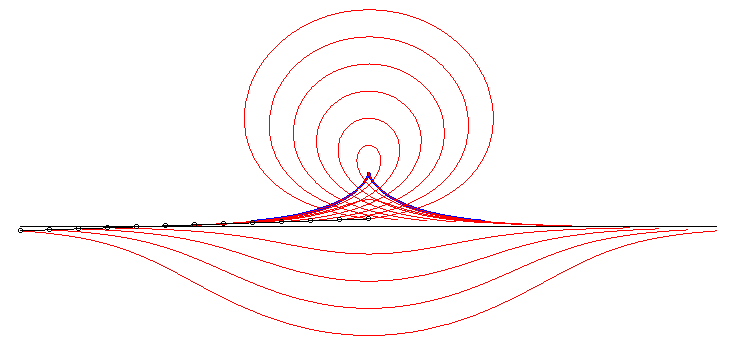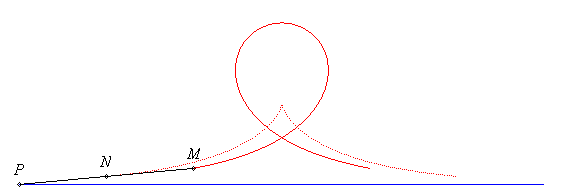SYNTRACTRIX, CONVICT'S CURVE

| next curve | previous curve | 2D curves | 3D curves | surfaces | fractals | polyhedra |
SYNTRACTRIX, CONVICT'S CURVE

| Curve considered by Giovanni Poleni in 1729 for the design
of a tractrix mechanism to build logarithms. Name given by Ricatti in 1755.
Curve then studied by Sylvester.
Other name: Poleni curve. Syn is a Greek prefix meaning "with". See Brocard part. comp. page 173. See http://www.spm.uem.br/bspm/pdf/vol21/parte-5-earp_BSPM.pdf page 12. |
| Cartesian parametrization Curvilinear abscissa: Radius of curvature: Hence the intrinsic equation 1 in the case of the convict's curve: |
The syntractrices are the curves described by the points of a tangent to the tractrix.
If the point N describes the tractrix, and P
is the point on the tangent at N located on the asymptote to the
tractrix (we know that NP = a = constant), then the above
parametrization is that of the point M such that .
| When N is the middle of [PM] (i.e. k
= 2), the curve is called convict's curve, which is also a special
case of elastic curve.
Here is a possible explanation for this name: A very heavy wagon is located at N, middle of a fixed rod MP; a first convict is at P and pulls the wagon N along a line; the wagon therefore describes a tractrix; a second convict pushes at M and therefore describes the convict's curve. More generally, when the front wheels of a vehicle describe a line, then the various points on its symmetry axis describe syntractrices. |

The calculation of the curvilinear abscissa above shows that the convict's curve is the curve that the end of a rod must describe, when the other one has a linear motion, so that the two ends (P and M) have the same absolute speed. |
| The convict's curve is the median
along Ox of the semicircle |
 |
| The convict's curve is also the special case k
= 2 of the family of curves with intrinsic equation 1: Opposite, an animation for k ranging from 0 to 6, with stops for k =1 (catenary of equal strength), k = 2 (convict's curve), and k = 4. |
 |
| next curve | previous curve | 2D curves | 3D curves | surfaces | fractals | polyhedra |
© Robert FERRÉOL 2021